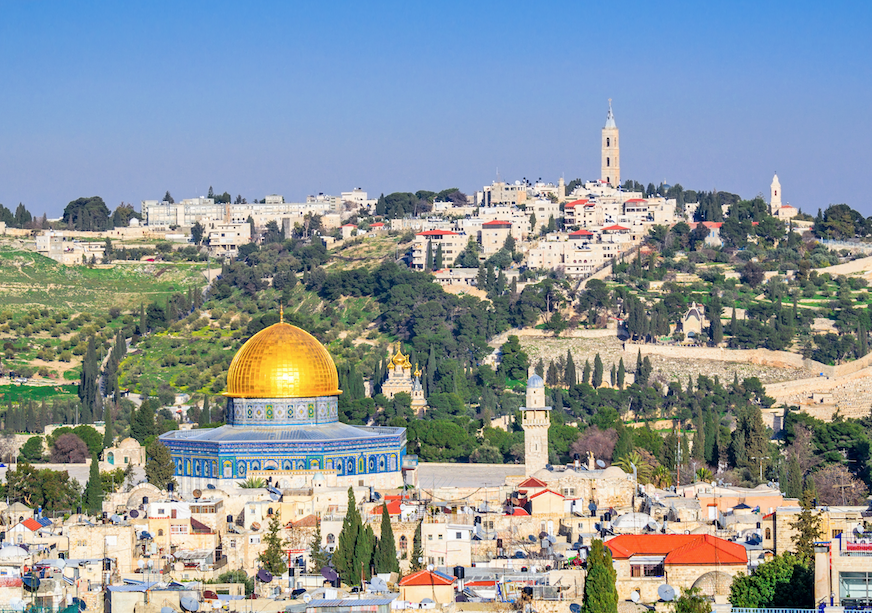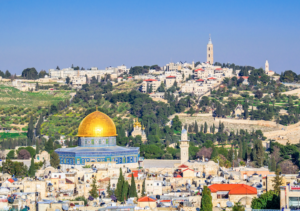Israel, a tiny country roughly the size of New Jersey, boasts a temperate climate. The Jewish state’s Mediterranean climate is marked by long, dry summers and short, cool winters. Rain is strictly a winter phenomenon.
By mid-April, spring is in full swing, with trees and wildflowers in bloom and daytime temperatures in the 70s (°F). The timing couldn’t be better given that on Passover, much of Israel’s citizenry — and countless tourists — are off from work and school, making them intent on discovering the nation’s most breathtaking sites.
While most can’t resist the allure of the open road, travel during Passover in Israel is not for the faint of heart, since locals and tourists alike pack into every corner of hotels, resorts, beaches and even public bathrooms.
“Maybe it’s a throwback to the pilgrimage holidays of ancient times, when we were all crowded on the road to Jerusalem,” says Yitzhak Sokoloff, founder of the Jerusalem-based Keshet Educational Journeys tour provider. “We have a national history of creating mob scenes, maybe because when you are a small people you need to come together to feel your strength.”
Yet Sokoloff says the itineraries diverge for tourists and the Israelis themselves.
“For people here with only a limited amount of time, they go for the greatest hits such as the Dead Sea and Ein Gedi. But Israelis have the opportunity to see the more hidden treasures,” he says.
Moving from south to north, here are 10 popular destinations for Passover travel in Israel—both the “greatest hits” and the “hidden treasures.”
Eilat
With temperatures hovering around the 80s, this southern resort city is a natural for scuba diving, an activity that peaks during the week of Passover. Other highlights include the picturesque Michrot Shlomo, the mines attributed to King Solomon.
Mitzpe Ramon
This small southern town is home to the Ramon Crater (or Grand Crater), which is one of the highest points in this part of the world and an excellent spot for stargazers to view the heavens without the distractions of artificial lights. Eilat resident Harold Berman, who since making aliyah from Massachusetts eight years ago has chosen a different trip for each Passover, recommends the Mitzpe Ramon-based museum dedicated to fallen Israeli astronaut Ilan Ramon.
Masada
Masada is known for both its stunning natural beauty, with vistas of the Dead Sea and the Judean Desert, as its historic significance—on this mountaintop in the 1st century, Roman troops surrounded the Jews, prompting 960 Jews’ mass suicide. Sunrise is the preferred time to set off on a hike up the mountain. Bring lots of water.
Kibbutz Kalia
There are plenty of hotels to choose from for a stay at the Dead Sea, the lowest and one of the saltiest points on Earth. But many Israelis prefer the picturesque simplicity of Kibbutz Kalia, perched on the northern end of the Dead Sea and a 35-minute drive from Jerusalem.
Emek Ha’Elah
Widely believed to be the scene of the iconic showdown between David and Goliath, Emek Ha’Elah (Oak Valley) is a picturesque spot in the Jerusalem hills, southwest of the city. Here, it is easy to imagine the boy who would be king loading his slingshot with the stone destined to slay the giant.
Jerusalem
One of the most gorgeous panoramic views of Jerusalem is from the Tayelet (Haas Promenade) in the southeastern corner of the holy city. It’s a breathtaking scene by day or night, encompassing a wide expanse including the Old City and the Hebrew University campus. It’s a relatively quiet corner of Jerusalem, and there’s even plenty of parking.
Tel Aviv
A city of immense contrasts, where else in the world would the ancient stones of the Carmel Shuk market converge with a modern thoroughfare of chichi boutiques? Where else would skyscrapers abut miles of pure white sand beach? (Okay—maybe Miami.) Don’t rush off at day’s end. Tel Aviv’s sunset should not be missed.
Zichron Yaakov
All grape-growing centers abound with golden light, and Zichron Yaakov is no exception. Situated 22 miles south of Haifa, the city offers welcoming shops, wineries and cafes, and stunning Mediterranean views. There’s also a museum commemorating the heroism of the Aaronsohn siblings—who took on the Ottomans of Turkish Palestine in 1917, sacrificing their lives in defense of the Jewish people.
Caesarea
Perched on the Mediterranean and founded by Herod the Great, Caesarea was a central port for the Roman invaders in the years leading up to the common era. It’s an archaeology buff’s delight. Much of Caesarea’s 2,000-year-old infrastructure remains intact to this day.
Kibbutz Lavi
A little-known gem of the lower Galilee, this kibbutz counts among its founders children saved from the Nazis through the famed Kindertransport rescue effort. Kibbutz Lavi not only boasts a classy hotel, but also a working farm and a factory producing furniture for synagogues around the world. Activities include horseback riding and a “senses garden” designed to delight all five senses.











Comments